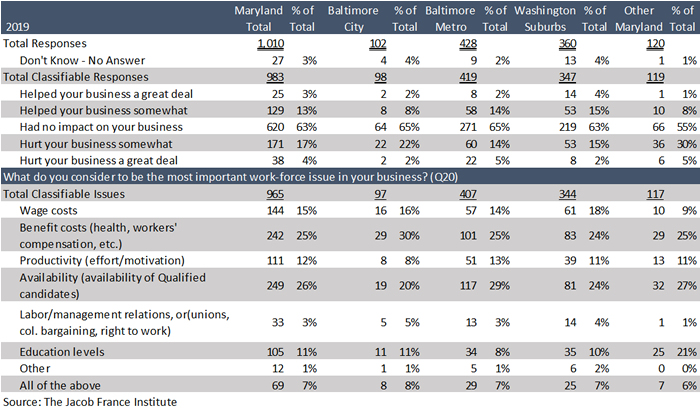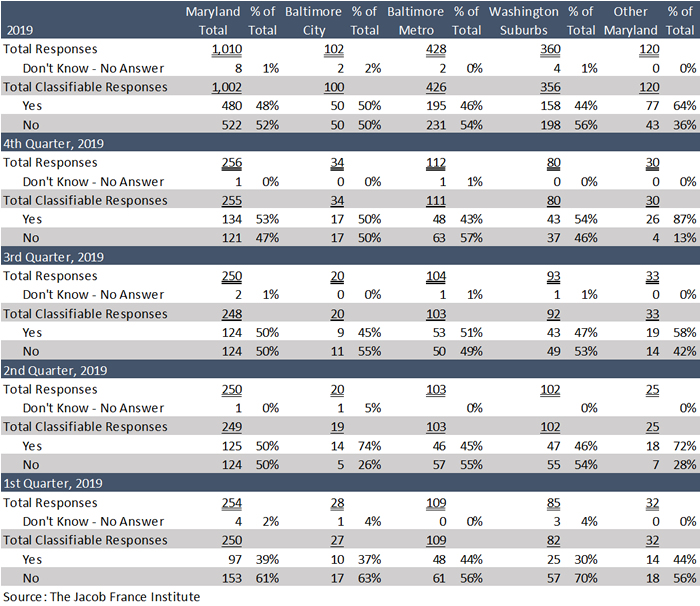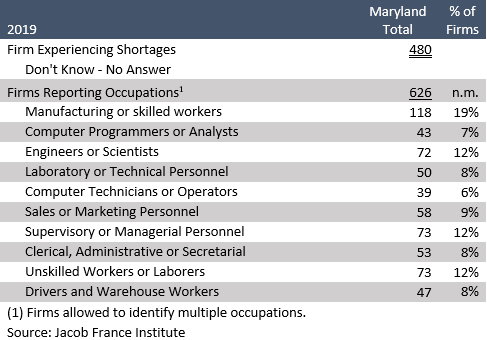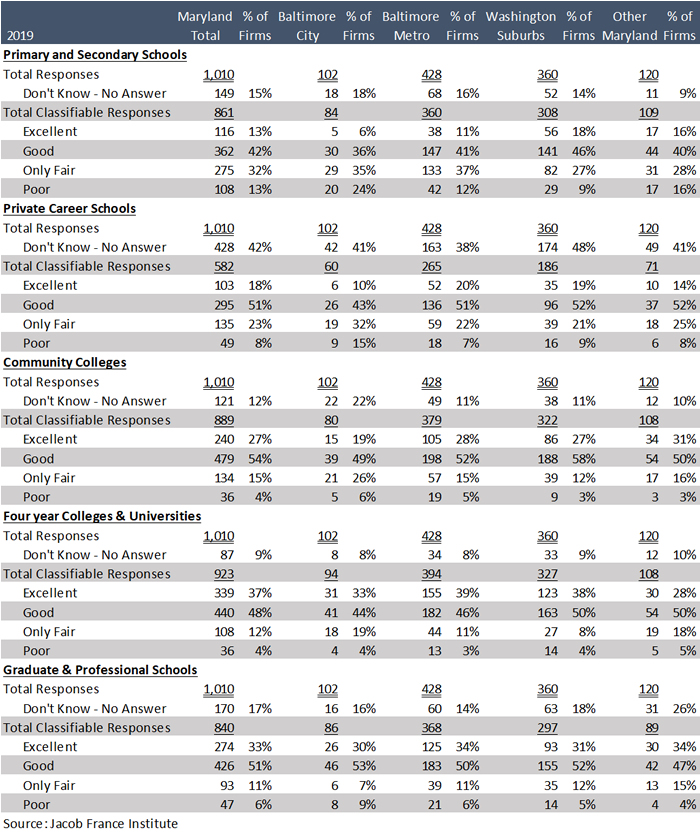Maryland’s Labor Market and Labor Force
With the national economic expansion now the longest on record and Maryland’s unemployment rate at 3.6%, finding the workers needed to support and grow operations has become increasingly difficult for businesses. The Jacob France Institute included more focused questions in this survey regarding how the local labor market is impacting business operations. The survey included questions on how labor market conditions are impacting business operations, worker shortages, recruitment, and satisfaction with Maryland’s education system.
Labor Market Conditions
The labor market was identified as a primary concern for business. Area Development magazine’s 33rd Annual Corporate Survey identified labor costs and labor availability as the top two factors businesses consider when rating a location’s business climate. According to the survey,
It’s no surprise that availability of skilled labor is the corporate respondents’ No. 1 factor in the location decision, considered “very important” or “important” by more than 90% of the respondents. Skilled labor is necessary in order to realize the potential of robotics and artificial intelligence that is driving Industry 4.0. Labor costs are ranked No. 2 in the Corporate Survey, followed by highway accessibility, which historically has held the first or second spot, slipping to the No. 3 ranking.
If the local talent pipeline is unable to supply the number and quality of workers needed by firms, then firms suffer by either having to hire and train less-qualified candidates, settle for under-qualified candidates, or recruit their employees from outside of the state. In the long run, if the local market is unable to supply the required talent, a company may choose to relocate to a location with a stronger labor market.
With the state and nation at full employment, assessing the impact of local labor market conditions on business operations is critical to understanding Maryland’s basic competitiveness. Firms were asked to characterize the overall labor market in Maryland and the greatest labor market advantage and disadvantage in Maryland. Overall, firms in Maryland are split on the impact of labor market conditions on their business operations, with 16% reporting that labor market conditions helped their operations and 21% reporting they hurt their operations, with 63% reporting no impact. When asked to identify the most important labor market issue impacting their business, some key issues arose:
-
Labor market availability (the availability of qualified candidates) was identified as the top issue by 26% of firms.
-
Benefit costs (health, workers' compensation, etc.) was identified as the top issue by 25% of firms
-
Wage costs (15%), worker productivity (12%), and education levels (11%) were identified as the third, fourth, and fifth most important issues.
Table 20: Have labor market conditions in Maryland hindered the ability of your business to meet its goals? (Q19 -20)

Worker Shortages
The key issue in assessing a state or region’s labor market competitiveness is whether it can supply workers with the education and skills needed by the local employer community. To assess this, firms were surveyed on whether they had experienced difficulty in obtaining workers, if these were short-term or long-term worker shortages, in addition to the positions they experienced difficulty in filling, and if workers had to be recruited from out-of-state. The key findings are as follows:
-
Overall, in 2019, 48% of businesses reported difficulties in obtaining workers with the skills necessary to fill specific job requirements, down from 56% in the 2018 survey. The share of businesses reporting difficulty in finding workers started the year at 39% in the first quarter, but increased over the next three quarters as national and state expansion continued.
-
The percentage of firms reporting difficulties in finding workers increased from the 2011 survey (the last year of the survey before this restart) with economic recovery, increasing from 38% of firms in 2011 to 56% in 2018, but decreasing to 48% in 2019.
-
Maryland firms appeared to be experiencing long-term difficulties in finding the workers needed, with 37% reporting difficulties in obtaining workers experiencing long-term shortages and 41% reporting both long- and short-term shortages. Thus, 78% of firms reporting difficulties in finding workers, or 37% of the total of 1,010 firms surveyed, were experiencing either long-term worker or both long- and short-term shortages in finding needed workers.
-
When asked about what types of workers firms were experiencing difficulties in hiring, Maryland businesses are experiencing workforce shortages across all skills and education levels.
-
At the lower skill level, 12% of responding firms reported difficulties in finding unskilled workers or laborers
-
At the middle skill level, 19% of responding firms reported difficulties in finding manufacturing or skilled workers and 8% of responding firms reporting difficulty in finding drivers and warehouse workers
-
At the higher skill level, 12% of responding firms reported difficulties in finding engineers or scientists and 7% reported difficulties in finding computer programmers or analysts
-
-
Compared to the 2018 survey results, the number of firms reporting difficulty finding workers fell across the high, middle, and lower skill levels, with:
-
Fewer firms reporting difficulty finding engineers or scientists (12% in 2019 compared to 18% in 2018) and computer programmers or analysts (7% in 2019 compared to 10% in 2018)
-
Fewer firms reported difficulty finding manufacturing workers, at 19% compared to 30% in 2018
-
Fewer firms reported difficulty finding unskilled workers, at 12% compared to 21% in 2018
-
-
When asked about steps required to address workforce shortages, 44% of responding firms reported they were forced to recruit workers from out of state and 7% said they had to recruit workers internationally using a H1B visa or other method.
-
Thirteen percent of firms reported that they experienced difficulty in hiring workers with a security clearance, down from 16% in the 2018 survey but up from 11% in 2011, indicating the growth of Maryland’s cyber- and national security business base.
Table 21: In the past year, has your company experienced difficulties in obtaining workers with the skills necessary to fill specific job requirements? (Q37)

Table 22: Were these short-term shortages that you were able to fill eventually, or long-term shortages of workers in specific categories, or both? (Q37b)

Table 23: For what types of positions did your company experience difficulties in recruiting? (Q37c)

Table 24: To recruit experienced workers, were you forced to recruit workers from out of state? (Q37d)

Table 25: To recruit experienced workers, were you forced to recruit workers internationally
using a H1B visa or other method? (Q37e)

Table 26: Have you experienced difficulty in recruiting workers with a security clearance? (Q37f)

Maryland Educational Institutions
Maryland businesses have a positive view of Maryland’s educational institutions. The local workforce development system is made up of the local K-12 educational systems, community colleges, private training institutions, and four-year colleges and universities. These educational and training institutions provide the pipeline of new workers required by the employer community.
Firms were asked to rate the effectiveness of Maryland’s educational institutions in providing a skilled and educated workforce. Maryland’s educational institutions were grouped into five categories: primary and secondary schools, private career schools, community colleges, four-year colleges and universities, and graduate and professional schools. Responses were categorized as excellent, good, fair, or poor. Overall, firms rated Maryland’s colleges and universities and its graduate and professional schools as being the best, with the overall responses being:
-
Primary and secondary schools: 42% of firms rated these schools as good and 13% rated them as excellent.
-
Private career schools: 51% of firms rated these schools as good and 18% rated them as excellent.
-
Community colleges: 54% of firms rated community colleges as good and 27% rated them as excellent.
-
Four-year colleges and universities: 48% of firms rated these schools as good and 37% rated them as excellent.
-
Graduate and professional schools: 51% of firms rated these schools as good and 33% rated them as excellent.
These results are consistent with the results of the 2018, 2011, and prior surveys, with firms maintaining a consistently positive perception of Maryland’s educational institutions over time.
Table 27: How would you rate the effectiveness of the state's educational institutions in providing a skilled and educated workforce that meets the needs of your company? (Q38 a-e)

<< Previous Page | Next Page >>